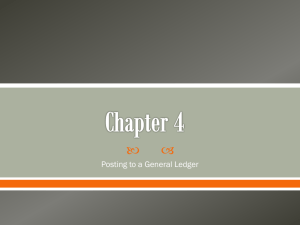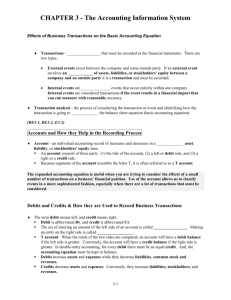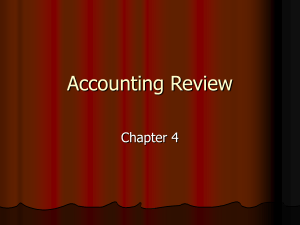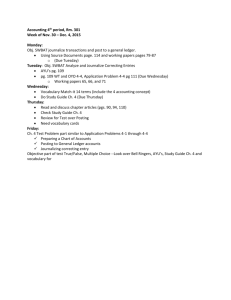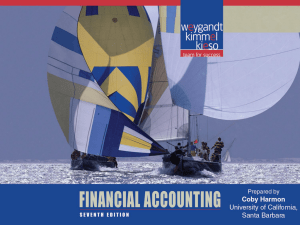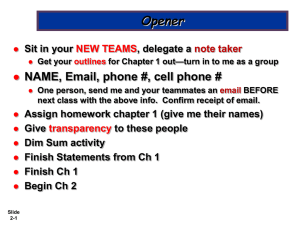Beginning the Accounting Cycle – Journalizing, Posting, and the
advertisement
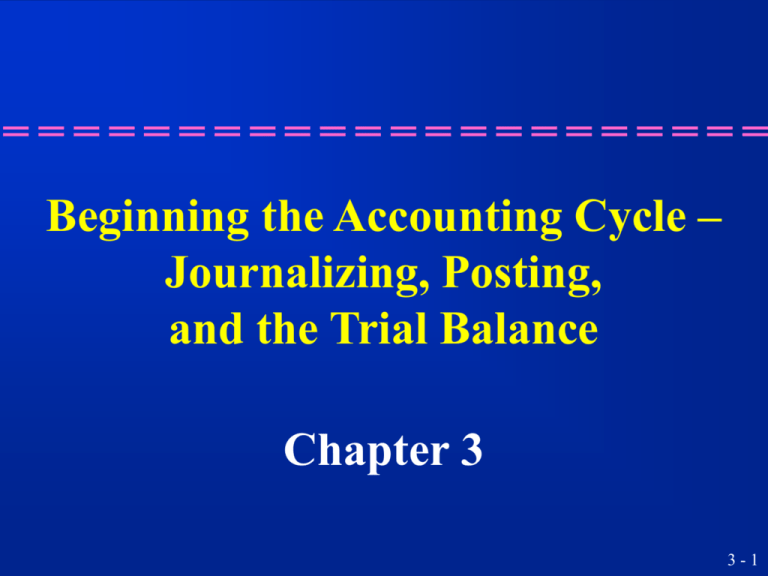
Beginning the Accounting Cycle – Journalizing, Posting, and the Trial Balance Chapter 3 3-1 Learning Objective 1 Journalizing: analyzing and recording business transactions into a journal. 3-2 The Accounting Cycle Accounting procedures are performed over a period of time. Procedures are performed in a definite order in the accounting cycle. The accounting period is a period of time covered by the income statement. Usually this is a twelve month period. The accounting cycle has sequential steps to be performed again each year. 3-3 The Accounting Cycle – – – – – – Accounting is the process that... analyzes, records, classifies, summarizes, reports, and... interprets. 3-4 The Accounting Cycle A sole proprietorship: – has one owner – begins with a monthly accounting cycle – owner has a capital and withdrawals account 3-5 Business Organizations All three types of business entities use the same basic accounting system. Sole proprietorship Partnerships Corporations 3-6 Recording Business Transactions The Accounting Period One Year Calendar year Fiscal year Less than One Year Quarterly Monthly 3-7 Learning Unit 3-1 The Accounting Cycle: 1 Analyzing 2 Recording transactions – journalizing 3 Posting to the ledger accounts 4 Preparing the trial balance The accounting cycle has some variations in a computerized accounting system. 3-8 Learning Unit 3-1 What is the general journal? It is the book of original entry. Transactions are written in a journal in chronological order. The format of the journal is important. Journalizing is the process of entering information as debits and credits to the correct accounts. 3-9 Learning Unit 3-1 What is the general ledger? It is the book of final entry. The information from the journal is transferred to the ledger in the posting process. Debits and credits in the journal remain exactly the same when posted to the accounts in the ledger. 3 - 10 Learning Unit 3-1 What is the chart of accounts? It is the list of accounts used by a business. Each business entity has its unique chart of accounts. Every chart of accounts has the same numbered account categories: – Assets, Liabilities, Owner’s Equity – Revenues, Expenses 3 - 11 Learning Unit 3-1 Journalizing Debits are always recorded first. Indent, then record the credit below the debit. A short explanation is included on the second line. Leave a space between journal entries. 3 - 12 Learning Unit 3-1 Debits must always equal credits. Amounts incurred for items that benefit future accounting periods are recorded as assets. What are some examples? – prepaid rent – prepaid insurance 3 - 13 Learning Unit 3-1 Amounts for items used (expenses incurred) in the current accounting period are recorded as expenses. What are some examples? – supplies used – rent for the month – expired insurance 3 - 14 Learning Unit 3-1 Amounts are recorded as revenue on the date in which they are earned. When are revenues earned? When services are performed, not necessarily when cash is paid. 3 - 15 Learning Objective 2 Posting: transferring information from a journal to a ledger. 3 - 16 Learning Unit 3-2 Posting All transactions are recorded in the journal, then amounts are copied to the ledger accounts named on the journal line. Once the amounts are entered into the accounts, a posting reference (PR) must be entered in the journal. New balances are computed in the running ledger accounts. 3 - 17 Learning Unit 3-2 Posting Account: Cash Account: 1000 Balance Date June 1 ref. debit jr1 5,000 credit debit credit 5,000 Insert the number of the journal page. 3 - 18 Example Journal Account and Explanation June 1 Cash Clara J. Capital Initial investment Page 1 Date Post Ref. debit 1000 5,000 3010 credit 5,000 3 - 19 Example Journal Account and Explanation July 3 Phone Expense Accounts Payable Paid phone bill Page 1 Date Post Ref. debit 5040 155 2000 credit 155 3 - 20 Example Journal Account and Explanation July 6 Insurance Expense Cash Page 1 Date Post Ref. debit 5060 150 1000 credit 150 Paid insurance bill 3 - 21 Example Journal Page 1 Date Account and Explanation Post Ref. debit July 8 Accounts Payable 2000 200 Cash 1000 Paid Accounts Payable credit 200 3 - 22 Example Journal Account and Explanation July 8 Accounts Receivable Service Revenue Performed Services Page 1 Date Post Ref. debit 1020 850 4000 credit 850 3 - 23 Learning Objective 3 Preparing a trial balance. 3 - 24 Learning Unit 3-3 Preparing the Trial Balance The trial balance lists the accounts that have balances in the same order as they appear in the chart of accounts. The trial balance will show if debits/credits have been interchanged, or if amounts have been transposed, or if a debit/credit was omitted or recorded twice. 3 - 25 Learning Unit 3-3 Some errors do not show, such as omissions or recording to the wrong account. Corrections before posting are made in the journal. An audit trail must be left. Do not erase – cross out errors and enter corrections. 3 - 26 Learning Unit 3-3 What about corrections after posting? This means that errors are also in the ledger accounts. Cross out incorrect amounts, change to corrected amounts, and record balance changes. 3 - 27 End of Chapter 3 3 - 28

